Volcanoes on Earth are extremely common. Earth is a very volcanic planet, and while our home-world may feature some truly impressive volcanoes, it is not the most volcanically active world in the solar system (that honor goes to a certain moon of Jupiter).
It may surprise you to learn just how alien some of these volcanoes are, though, from pancake and tick volcanoes that bubble up from the surface of Venus to volcanoes that literally erupt ice and methane, here are the top 10 volcanoes in the solar system (not including Earth, of course!).
10. Maat Mons (Venus)
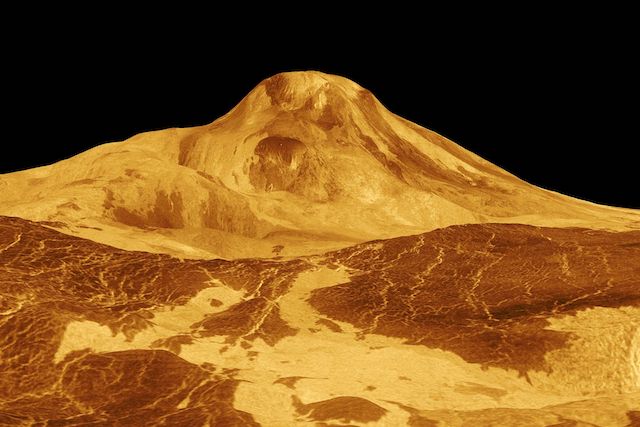
Named after the Egyptian Goddess of Truth and Justice, Maat Mons on Venus is an absolutely massive volcano, rising 8 kilometers above the mean planetary surface and almost 5 kilometers about the land in the area where it’s located. It is also the tallest mountain or volcano on the planet.
Maat Mons was surveyed by Magellan’s synthetic aperture radar. This radar data was then used to create an impressive 3D map of the volcano and the surrounding terrain.
At the top of the volcano, the summit caldera is around 28 by 31 kilometers in size and within that area are at least five other collapse craters that are each around 10 kilometers in diameter. Flows of liquid magma descend from the volcano, and more recently, evidence of active volcanism around Maat Mons was revealed as new ash flows near the summit and north flank.
Given the absolutely immense heat and pressure that the surface of Venus experiences, if you were able to see this volcano with your own eyes (without suffering a very painful and immediate demise) it would be a truly alien sight to behold.
9. Ice Volcanoes on Europa
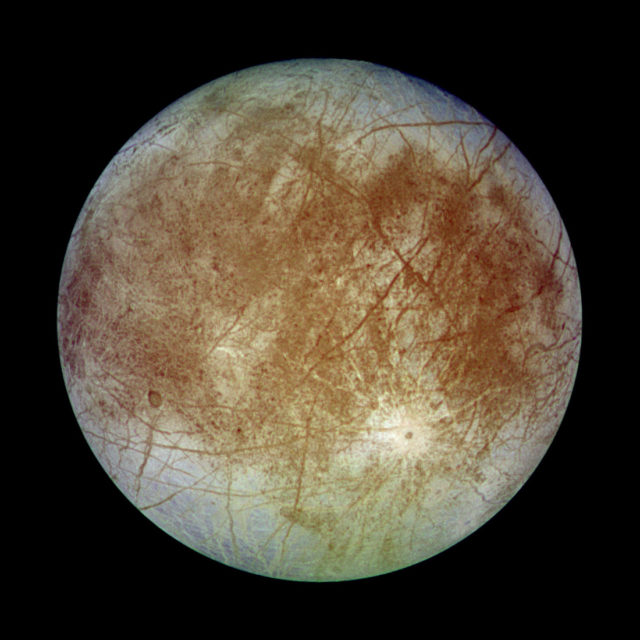
Europa is a truly fascinating moon. Its orbit around Jupiter causes it to experience extreme tidal forces that effectively heat the interior to such a degree that it’s suspected to have a subsurface ocean and maybe even life.
But Hubble spied something that makes Europa even more interesting. Plumes of ice shooting up over the surface of the moon, suggesting that the moon actually features something called cryovolcanoes. Scientists believe that this cryovolcanism may behave very similarly to the way good old fashioned magma volcanoes work on Earth.
These cryovolcanoes are likely to behave very similar to the way geysers do back here on terra firma. Ice volcanoes erupt with volatiles, releasing methane gas, water, carbon dioxide, and ammonia into the atmosphere (if the moon in question has one).
8. Ice Volcanoes on Titan

Speaking of ice volcanoes, we would be remiss if we didn’t mention Titan, one of the most Earth-like bodies in the solar system. Titan orbits Saturn along with 52 other moons, and just so happens to be the most interesting and significant of them.
Not only is Titan the only moon (out of 150 in the whole solar system) with a significant atmosphere, but its surface is also covered in rivers, pools, and even entire seas of liquid methane. It also features clouds made of gaseous methane and ethane.
The pressures on Titan are about 50% greater than Earth, and if you were to stand on its surface, you’d be able to fly through Titan’s sky by simply jumping and flapping your arms (well, not really, a person would need large mechanical wings attached to them).
But interesting enough, Titan also has been observed to have cryovolcanoes as well. Beneath Titan’s icy crust is an ocean of liquid water much like the subsurface ocean beneath Europa.
Scientists observed cryovolcanic activity on the landform known as Sotra Facula. The pictures, taken by NASA’s Cassini Spacecraft, show three large cone-shaped land formations with icy material flowing from them as well as pits that range from 1,000 to 1,500 meters deep.
7. Pancake Domes (Venus)
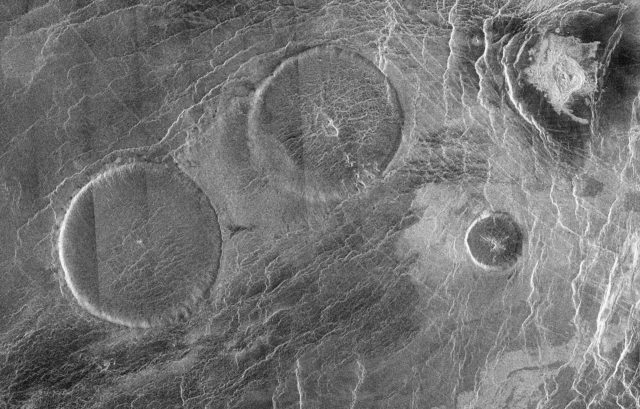
Venus is the solar system’s most volcanically active planet, but that volcanic activity is pretty different from the form it takes on Earth, for one, Venus does not have global plate tectonics.
Its volcanoes also take on some pretty strange forms, one of those being what are known as pancake domes. These things are truly odd, as they appear to be just as common as shield volcanoes on Venus, but only seem to pop up in the lowland plains.
Pancake domes tend to be very wide at their base, but only reach an average height of 1 kilometer above the surface of the planet.
The volcanoes get their name from the fact that they’re made from magma bubbling up from the surface, rather than what we’re used to on Earth, where volcanic activity causes a mountain to rise up above the surface. This takes the form of an extremely slow eruption, culminating in the formation of a vent near the middle of the volcanic dome.
The domes are usually aligned in strings as well, and to the untrained eye, almost look like craters that pockmark the surface.
6. The Lonely Mountain (Ceres)
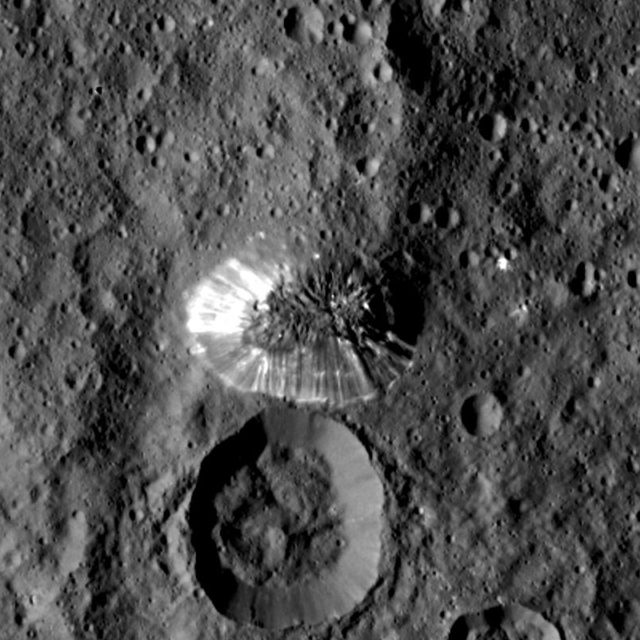
The dwarf planet Ceres, which orbits the sun between Mars and Jupiter, is not only the largest object in the asteroid belt but is also home to one of the most fascinating geological features in the solar system.
The Lonely Mountain, nicknamed after Mount Erebor in J.R.R. Tolkien’s work, Ahuha Mons appears to be a shield volcano that rises 4 kilometers above the surface of Ceres, but unlike most shield volcanoes on Earth and others throughout the solar system, this one appears to be a cryovolcano that produces flows of slaty mud.
The reason for these surprising properties lies in Ceres’ unique composition, as the dwarf planet is mainly composed of salts, water-ice, and muddy rocks. Though the ice volcano is thought to be dead now, the evidence collected by NASA’s Goddard Space Flight Center suggests that this salty mud cryovolcano was active in recent geological history.
5. Tick Volcanoes (Venus)
Like the pancake domes that adorn Venus’ lowland plains, tick volcanoes are very similar but exhibit some interesting differences from their domed brethren. They’re mostly flat with faults and striations that run away from the base of what you might call the “body” of the tick, creating the “legs” of the object.
They also appear to be just as wide as pancake domes, ranging from 22 kilometers to 66 kilometers in diameter.
What sets these volcanoes apart from pancake domes are the radial ridges that can be seen flowing away from the “heads” of the volcanoes. The origin for these features appears to be a bit of a mystery too, as scientists aren’t certain whether they’re the leftover scars from avalanches or dikes that were created during their formation.
4. Tharsis Montes (Mars)
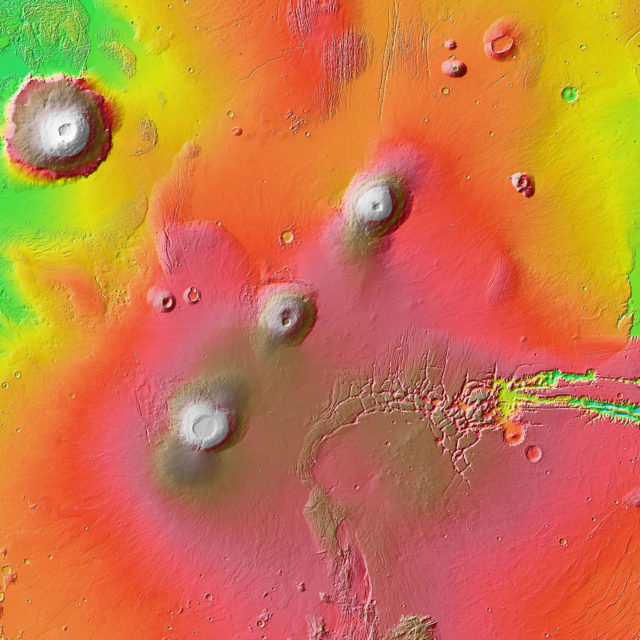
The three volcanoes that make up the Tharsis region of Mars are truly fascinating, as they’re all arranged in a row, and appear to be similar sizes from one another. If that wasn’t enough, the granddaddy of all volcanoes in the solar system is just north of them.
All told, this region is about 4000 kilometers across and most of the volcanoes here and 10 kilometers tall. Despite the three largest volcanoes (not including Olympus Mons) being Ascraeus, Pavonis, and Arsia Mons, there are actually 12 volcanoes in this region.
Even though Arsia Mons isn’t the largest volcano on the planet, it does boast the largest caldera clocking in at a massive 120 kilometers in diameter.
Another thing that separates the volcanoes on Mars when compared to those found here on Earth is their sheer size. Volcanoes on Mars are absolutely massive, most of them ranging from 10 to 100 times larger than any volcano on Earth.
3. Pluto Ice Volcanoes
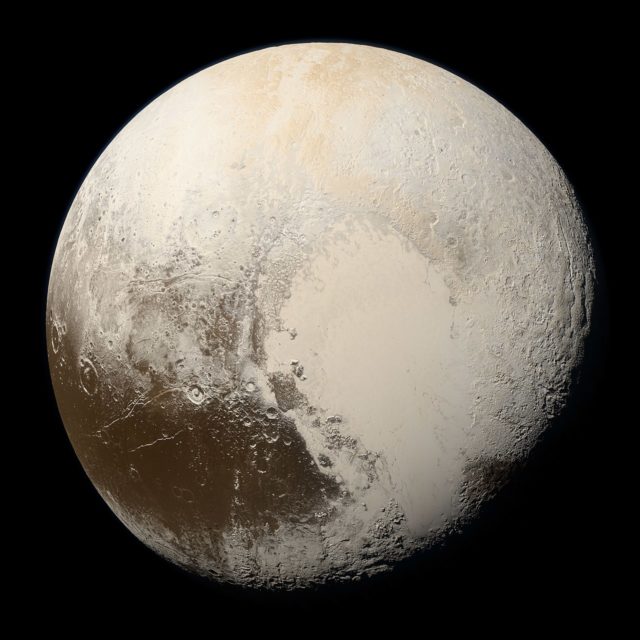
The Pluto system is a truly fascinating part of our solar system. New Horizons showed us a cold but geologically active world (and one that looks like it’s giving Earth a big old heart emoji too). Pluto is a small dwarf planet that is mainly made of molecular nitrogen, with a smattering of carbon monoxide and methane for good measure.
Pluto’s colorful landscape is dotted with mountain ranges and in the periods of its immense orbit when it’s closest to the sun, it even develops its own tenuous atmosphere (something that is incredible considering how far away this world is from us).
But New Horizons also revealed the presence of two cryovolcanoes on the surface, what are being called Wright Mons and Piccard Mons that take the form of mounds of ice featuring rims that tower up to 5 or 6 kilometers above Pluto’s surface. They’re also located outside Sputnik Planum, that smooth heart shape that set the internet on fire when the first images of Pluto got beamed back from New Horizons.
The rims at the top of these mountains are each nearly 150 kilometers across and are just as deep as the mountains are tall. These pits are also where the volcanoes would spew molten methane and ice.
2. Io
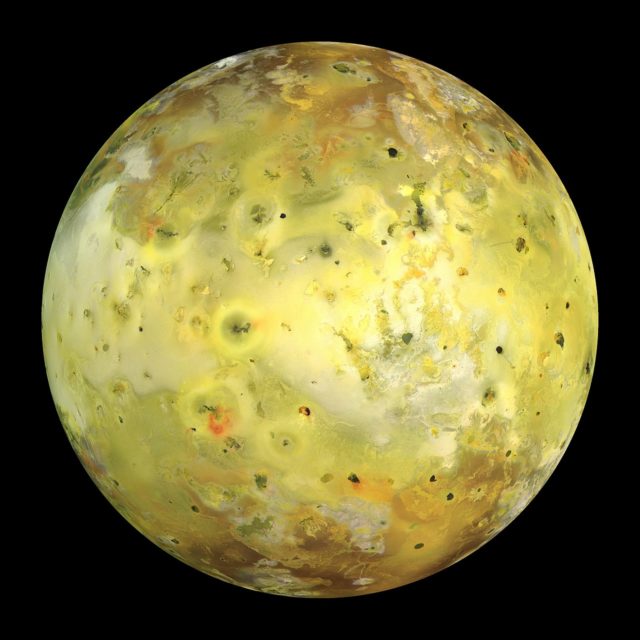
Io is not only the most volcanically active moon orbiting Jupiter but also the most volcanically active object in the solar system, outranking even Venus in that regard. We first learned about Io’s incredible volcanism over 40 years ago, when NASA’s Voyager 1 probe careened past the moon.
The surface of Io is dotted with hundreds of volcanoes, which is an impressive number considering the moon’s radius. One caldera, called Loki Patera, is over 13,035.69 square kilometers in size.
That certainly puts the Yellowstone caldera to shame.
In fact, most of the volcanic activity and the volcanoes that produce it are located in the “wrong places,” (in other words, not in the usual areas where scientists would expect them to be). And, in addition to this, most of the eruptions seem to be focused on one hemisphere of the moon, with Loki Patera taking up 10% of Io’s total heat production.
If all of that wasn’t enough to set Io apart from the competition, its eruptions are especially powerful, sometimes so intense that they cause the moon’s brightness to double.
1. Olympus Mons (Mars)
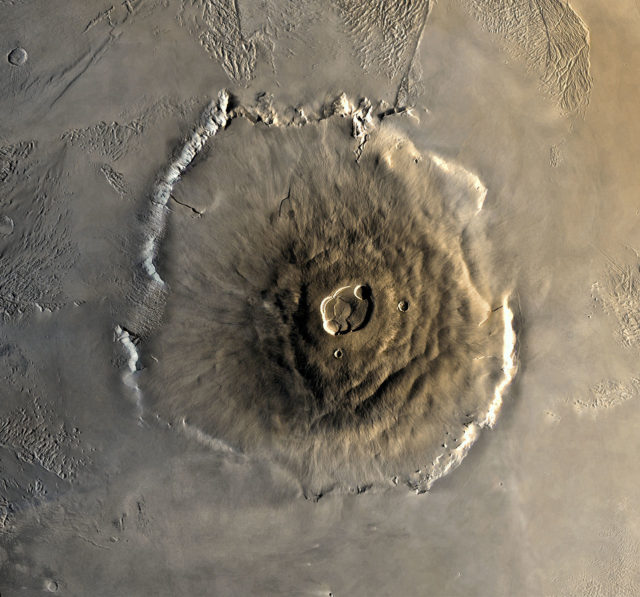
Olympus Mons is the granddaddy of all volcanoes in the solar system and takes up an area comparable to the state of Arizona in the United States. That’s 624 kilometers in diameter!
It’s a shield volcano reaching an Everest shaming 25 kilometers in height, with a caldera that’s 80 kilometers wide. Compared to the largest volcano on Earth, Mauna Loa (also a shield volcano), Olympus Mons is about 15 kilometers taller.
But why is it so large? Well, eruption flows on Mars are thought to be much longer than those found here on Earth, and this is thought to be attributed to a higher volume of eruptions in general on the red planet.
Another reason is that Mars’ crust doesn’t behave the way the Earth’s does, so instead of the crust moving over a static hotspot, it remains stationary, so the lava continuously builds up beneath the surface until you have a monster-volcano like Olympus Mons.
While Olympus Mons has been thought to be dead for decades, new research suggests that the planet may merely be dormant, meaning that the solar system’s largest volcano may erupt someday in the future.